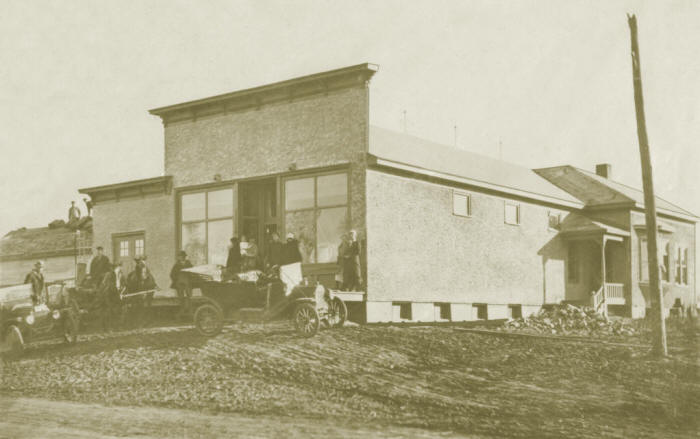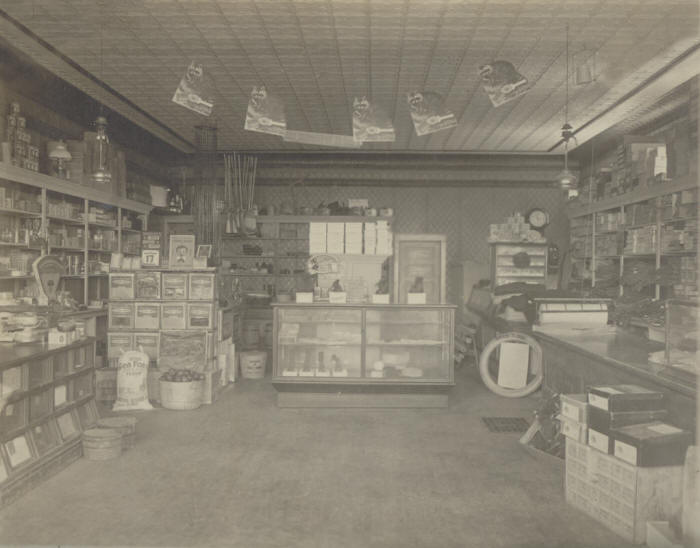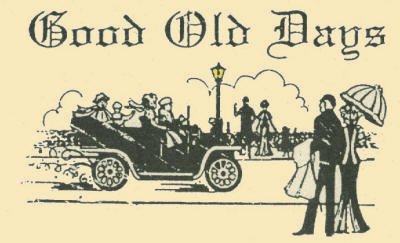|
|
|
Clark County Press, Neillsville, September 26, 2007, Page 24 Transcribed by Dolores (Mohr) Kenyon. Index of "Oldies" Articles
Compiled and contributed by Dee Zimmerman
Clark County News |
September 1907
Last Sunday, a large delegation from Neillsville visited Hatfield. One hundred went by train and others drove across the country. A special took the visitors from Merrillan to Hatfield, after dinner and left in time to catch the midnight train home. The Neillsville Nine and the Hatfield Engineers engaged in a game of baseball, which reported to be quite interesting up to the fifth inning, when the score stood at 2 to 2. Hatfield then took the lead, winning 12 to 2.
There was a family reunion at the home of C. Esselman, in the Town of Loyal last Monday. All of their children were present, as follows: Mrs. Jos. Leonard, of Marshfield; C. B. Esselman of the Town of Loyal; Mrs. Jos. McKimm of the Town of York; H. B. Esselman of Athens; Mrs. Joseph Herbst of Brainerd, Minn.; Miss Josie Esselman of Omaha, Nebr.; Miss Amelia Esselman of Neillsville and Misses Mary and Augusta Esselman and Louis Esselman who are still with their parents.
Robert B. French is the son of Capt. John R. French, deceased. He was born in New York State and came with his fathers family to Iowa when a small boy, and to Clark County in 1853. In the family were six sons, James, Joseph, John, Wash, Benjamin F. and Robert B., all of them remarkable men. There were also three sisters who grew to womanhood: Mrs. Johnson, who died in Washington; Mrs. Brooks in Pennsylvania, and Mrs. James Sturdevant, Sr., of Neillsville. Of this family, only R. B. French survives.
He got some land, a part of his present home when only seventeen years of age. He soon went into saw milling in which he became an expert. He also logged and ran the Black River, leading an active life. He was married in 1864. In 1873, he went to Hatfield to keep a hotel, remaining in that business for nineteen years. His wife died in 1892, about the time he was moving back on the farm.
For years, he did a considerable sawmill business at the farm, but about two years ago, his last mill was burned and he has not rebuilt. He has met with six disastrous fires in his hotels, farmhouse and mills, losing many thousands of dollars. For some years past, his son Robert B. Jr., has carried on the business of the farm and mills.
A deal has been completed, this week, which means that the Neillsville Overall Factory will become a big institution in the near future. Carl Rabenstein, since his return from Europe, has been anxious to go into some manufacturing business, which would occupy his time and some capital, and help build up the city. He has quietly watched and studied the work in the overall factory, and came to the conclusion that with additional capital and enlarged facilities its business could be extended almost indefinitely, with fair promise of profits.
Acting on this decision, he has entered into a partnership with M. Horn, the present proprietor, and has purchased the washboard factory to be fitted up for a new home for the overall business. Mr. Rabenstein began energetically, at once, to remodel the buildings. They will be raised to street level, and a nine-foot basement will be built beneath for an engine room, closets, fuel, etc. The first floor will be fitted up to accommodate 75 machines, and the second floor will be used for manufactured stock. The ell part, which stands with end to the street, will be used as a receiving and shipping room.
A crew of men, under the direction of Gus Krause, is busy at the work. Wednesday, Mr. Rabenstein was out and made contracts for stonework, all along the line today. Tuesday, Mr. Horn went to Chicago to look up more machines of various kinds, an electric cutter being one of the most costly to be installed. Some large contracts are open for the new firm, which they expect to be able to hold.
Elmer Selves and crew, this week, completed a stone silo on the Maple Glen farm. It is the first of its kind in this locality. If it proves serviceable, it is probable there will be others like it, being built entirely of stone.
Mr. and Mrs. C. C. Sniteman mourn the death of Polly, their wise and cunning parrot, which for a long time was the delight of everyone who made her acquaintance. The bird seemed endowed with almost human intelligence and affection, knowing her friends and reciprocating good treatment at all times.
Every boy in this county can earn enough to buy a suite of clothes and an overcoat for winter wear, if he will go picking green cones from the White Pine tree.
These cones bring one cent a pound in Neillsville and each tree has from 50 to 250 pounds of cones on it. After school hours, a boy can earn good wages gathering the cones, which are now ready for picking. The Luethe Co. is making arrangements to handle all cones that can be picked in this locality.
September 1942
The old Withee homestead on North Grand Avenue, which was purchased some time ago by James Milton, is undergoing repair and improvements. A new enclosed porch has been built on the west side to replace a large open veranda, with a new outside cellar-way beside it. The porch, which extends across the front of the house, will also be replaced by a smaller porch. The entire exterior of the house will be painted white, trimmed in green. The Miltons are also resurrecting as many of the original blinds as possible and are bringing them back to a state of usefulness.
The one remaining building that was used as a business place in Columbia has been sold to Herman Embke, who is busily engaged in tearing it down. The structure was built by a man named Coply, in about 1896-97. He operated a store and also lived in the building. A number of people living here now, recall when the building was erected. Since then the store has been operated by numerous individuals, but finally became only a dwelling place.
Mr. Embke has also purchased the garage, which was built by August Schlender when he conducted a business establishment in Columbia a number of years ago. This building will also be razed and he material from both buildings will be taken to Mr. Embkes farm, where he intends to use in building a poultry house. Mr. Embke made the purchase from William Sollberger who owned the buildings. With the Columbia lots vacated, the removal of the depot and the switch track, and the razing of these buildings, one can truly say that Columbia is a ghost town and has vanished into the past.
C. H. Roener and son, William Roener, of Hartford, Wis., arrived here last Wednesday. They will spend several days at the home of the C. H. Roeners nephew, Leland Bandelow.
Mr. Roener formerly was a Clark County farmer. He owned a 160 acre farm near Loyal, then known as the Joe Marsh farm, purchased from Dave Lindner. That property, with the added acreage, is now owned by John Elsinger.
Mr. Roener was directly responsible for the first mail route out of Loyal, drawing up and circulating a petition among the prospective patrons. He spent much of his time explaining advantages of the rural service, only to be met by strong opposition from the postmaster and from the businessmen of Loyal.
Having written to Congressman John J. Esch of La Crosse, asking for cooperation, his efforts were eventually rewarded with the reply that in the shortest possible time, the mail route in question would be established. The first carrier, Fred Church, was appointed in 1903, the route extending north and east of Loyal.
Mr. Roener also built the first round silo in Clark County, blasting the stone for the structure out of the mound in the Town of York, and hauling it to his farm. He also was instrumental in soliciting funds for building the Evangelical Emmanuel Association Church, at Spokeville.
Mr. and Mrs. Roener are the parents of eleven children, five of the sons being farmers; a sixth son is employed as a condenser with the Dairyland Cooperative plant at Juneau, Wis. Four daughters are graduate nurses; a fifth who taught school for 15 years, is married to a farmer at Van dyne, Wis. All of the children were given an opportunity to procure an education. Mr. and Mrs. Roener had resolved to give their children those privileges which they themselves had been deprived of.
Mr. and Mrs. Leo Henchen have returned from their wedding journey to Milwaukee and Waukesha. They have taken up residence with the brides parents, Mr. and Mrs. Hugo Klauer.
The wedding took place Saturday, September 5, at Immanuel Lutheran Church, Globe. The wedding ceremony was performed by the pastor, Rev. Adolph Schumann.
Gertrude Klauer, the bride, wore a floor-length gown of white silk embroidered organdy, fashioned along princess lines and extending into a long, graceful sweeping train. She was attended by maid-of-honor, Miss Elaine Welke, a friend; Miss Doris Henchen and Eleanor Klauer were bridesmaids. The groom was attended by Herbert Henchen, a brother of the groom, as best man; by Arnold Klauer, cousin of the bride, and Wilbert Henchen, brother of the groom, as groomsmen.
A 5 oclock supper was served to about 100 relatives and friends at the home of the brides parents.
Nation-wide gas rationing to save rubber is definitely on the way. This will mean a top speed of 35 miles per hour for automotive vehicles, limitation of driving to that is absolutely necessary, and a maximum of 5,000 miles per year for each car.
These drastic steps will be taken in consequence of the findings of the special committee, which researched rubber tires, headed by Bernard Baruch. The committee found the existing circumstances so dangerous that unless corrective measures are taken immediately, this country will face a military and civilian collapse.
The Granton school bus is temporarily out of commission. On the first day of school August 31, a connecting rod broke and damage was done to the motor. The parts have been slow in arriving, and the school authorities have not received a hopeful prophecy as the time of their receipt. So, four passenger cars are making the rounds to pick up the 36 pupils on the bus route. Some of these cars are making two trips night and morning, four trips daily. The cars are being driven by Mrs. William Schmidtke, secretary of the area school board; Armin Moh, a member of the board; William Young, the regular bus driver; and Mr. Kinney, the instructor in agriculture.
Something new is being served at Club 10, east of Neillsville. Eat Chicken on the Straw, which is Delicious Chicken smothered in French Fries. It will be served anytime for only 35c, in celebration of Labor Day.
The Trondhjem Scandinavian Evangelical Lutheran Church of Clark County was organized on October 13, 1902, with the following charter members: Peder Christopherson; Simon B. Johnson; Jonas Hembre; Hans Ystad; August Gustafson; Ole Bragstad; Iver Hembre, Morton Johnson and Christian Christianson. Of these, Hans Ystad and Morton Johnson, both of Greenwood are the only living charter members.
Permission was granted to hold their meetings in the old red schoolhouse, which stood across the road, south of where the Trondhjem Church now stands, two miles northeast of Greenwood.
One Sunday during the winter of 1902-1903, Iver Rembre, Simon B. Johnson and Ole Peterson drove to Longwood to attend church services and hear the Rev. J. C. Haugum preach. They were entertained for dinner at the home of Mr. and Mrs. P. C. Johnson, who then lived at Longwood and later moved to Greenwood.
Their report resulted in the calling of the Rev. Mr. Haugum as pastor of Trondhjem Church.
On April 28, 1903, little Elenore Hembre, daughter of Mr. and Mrs. Iver Hembre, was baptized, being the first baby to be baptized after Trondhjem Church was organized.
On May 18, 1903, it was decided to postpone the building of a church, and to use the old red schoolhouse for services. Some time later, this schoolhouse burned down and the Christopherson School was built on its present site. Church services were held there until the congregation decided to build a church at a special meeting on November 15, 1909. Simon B. Johnson had leased one-half acre of land to the congregation for the church building. The building committee appointed, included P. C. Johnson, Ole Bragstad and Iver Hembre.
By this time, new families moved into the neighborhood and new members had been added to the congregation. Some of them were: Andrew Olson, Peder Anderson, Ed Englebretson, Ole Peterson, Mrs. Kolstad, Austin Severson, P. C. Johnson, David Danielson and John Wisth.
Rev. Haugum secured the blue prints and helped in every way possible in the building of the church. David Danielson, Sr., was head carpenter, and all other members aided him in the building of the church, which was dedicated on March 22, 1912. Rev. Haugum served until 1914, when Rev. Erdahl was called to succeed him. Due to ill health, Rev. Erdahl was able to serve but one year. In 1915, Rev. Erdahl was succeeded by Rev. Theodore Kleppe who served until 1918. Then Rev. M. K. Aaberg was called and is still serving the congregation. The church was dedicated and completely equipped by 1917.
The Ladies Aid, which was organized years before, was responsible for equipping the church. A large box was used for an altar and rough benches for seats, until they felt they could afford to buy the present interior equipment.

The Longwood Store, as construction was near completion circ 1920, at its location along Highway 73.
Photos courtesy of Norma (Warner) Telford of Eau Claire and website http://www.wiclarkcountyhistory.org/

The Longwood Store, interior view.
€€€€€€€€€€€

